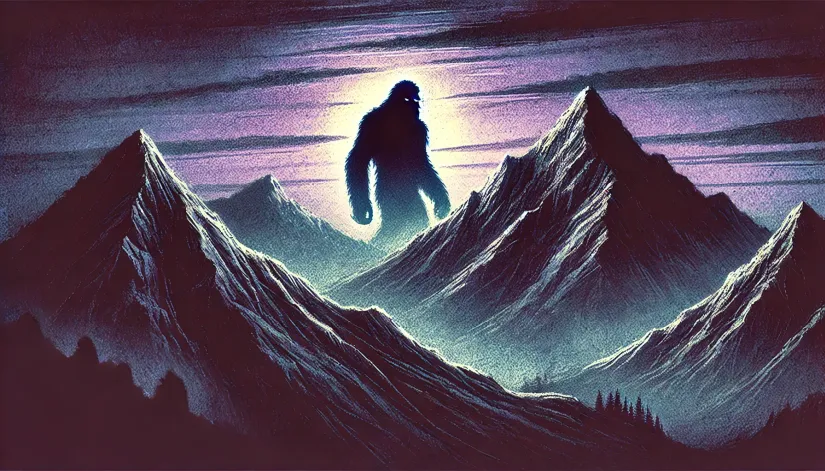The Himalayan mountain range isn’t just famous for its jaw-dropping vistas, rough terrain, and unpredictable weather—it’s also the legendary stomping ground of the mysterious Yeti.
Despite the lack of hard scientific evidence supporting its existence, numerous Yeti myths continue to swirl around this enigmatic figure. Some folks believe it’s an extraterrestrial or a genetic experiment gone haywire. Others see it as a spiritual being connected to the natural world.
Let’s dive into some of the most famous Yeti myths and legends that have kept this creature alive in the hearts and minds of people worldwide.
Listen to our article:
In this article:
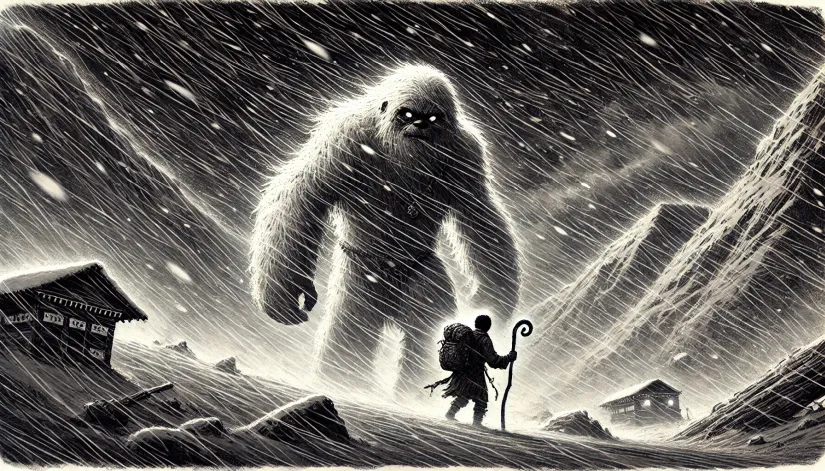
The Story of Tenzin and the Yeti Guardian
The first captivating Yeti myth in our list portrays the creature as a guardian spirit of the Himalayas. In this myth, the Yeti isn’t just a physical being but a spiritual entity that protects the mountains and all who respect them.
The myth goes like this:
High up in the majestic Bhutan mountains—where the peaks touch the sky, and the air is thin and crisp—lived a young shepherd named Tenzin. He was a humble soul. His whole village loved him for his hard work, kindness, and profound respect for the land.
Tenzin would take his sheep through the winding trails every morning, humming tunes that echoed softly against the rocky slopes. Life was good.
However, in one year, the winter came much sooner than usual. The food was scarce, and his sheep were hungry. The shepherd had to do something: take the flock to a pasture at a lower altitude where the grass was still green and plenty.
But while on his way there, the sun suddenly dipped behind the mountains. Much earlier than usual. Dark, menacing clouds gathered on the horizon. A great storm was coming.
Tenzin kept going. He rushed his sheep on a trail that cut through one of the peaks. But it was too late.
A blinding snowstorm suddenly swept in. And once familiar landscape turned into a bewildering expanse of white. The wind howled like a hungry wolf, and snowflakes stung his face like tiny needles.
Tenzin realized he had lost his way. The trails were buried under feet of snow, and every direction looked the same. The cold was relentless. Seeping through his clothes and chilling him to the bone. His sheep huddled close, bleating nervously.
Desperate and fearing the worst, he shouted for help. But no one could hear him in the roaring storm.
Just when hope was slipping away, a colossal figure appeared from the swirling snow. The creature was huge. At least eight feet tall and covered in thick, snow-white fur.
Its eyes glowed softly like warm embers, and despite its intimidating size, there was something reassuring about it. The young shepherd knew at once that this was the same creature of the Yeti myths his grandmother used to tell him.
The Yeti extended a massive hand, gesturing for Tenzin to follow. Too cold and exhausted to hesitate, the man gathered his sheep and followed behind the beast.
Soon, they reached a hidden path. Never seen before. But protected from the worst of the wind and snow. At the end of this trail, Tenzin spotted a small cave hidden behind thick icicles.
Inside, the air was surprisingly warm. A fire crackled invitingly, and piles of dry wood and provisions were neatly stacked against the walls.
Overwhelmed with gratitude, Tenzin turned to thank his mysterious savior. But the creature was already gone. Silently faded into the night.
After a day and a night, the storm had finally passed. Sunlight filtered into the cave, casting shimmering patterns on the walls. The man stepped outside, and, remarkably, he recognized his surroundings. To his surprise, the cave was not far from his village.
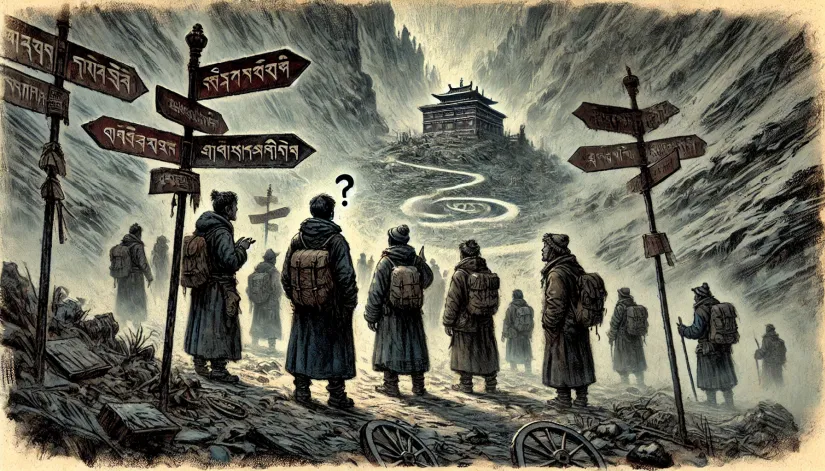
The Lost Merchants of Tibet
Some Yeti myths depict the creature as a trickster, playing pranks on unsuspecting travelers. In these tales, the Yeti might mimic human voices to lure people off their paths or rearrange trail markers to confuse them.
One of these Yeti myths goes like this:
A small group of merchants were crossing the mountains through a mountain pass. Eager to reach their destination, they pressed on through the pass as dusk settled in.
But soon, the bitter night cold settled. The merchants tightened their cloaks against the cold, their breath forming little clouds in the crisp air. Just then, the silence was shattered by faint cries echoing through the valleys: “Help us! Please, is anyone there?”
The group stopped. “Did you hear that?” one asked. “Sounds like someone’s in trouble,” another replied. Despite the creeping darkness, they couldn’t ignore the pleas for help. So, they veered off the well-trodden path, venturing deeper into the unfamiliar wilderness to locate the distressed voices.
They followed the cries. But with each step the merchants took, the voices seemed to drift further away. The terrain grew more treacherous—rocky inclines, dense thickets, and sudden drops challenged their progress.
The men called out. Yet, no answer came except the haunting echo of their own voices. Hours slipped by, and the realization set in: they were lost.
When dawn finally broke, the weary merchants expected to find themselves deep within the mountains. However, to their astonishment, they stood at the very spot where they’d first heard the mysterious voices—the entrance to the mountain pass.
SpookySight recommends:
- Is the Almas a Relict Hominid? Theories, Sightings, and Modern Expeditions
- Barmanou: The Beast of Chitral. Real or Myth?
- 13 Yeti Expeditions That Left Scientists Baffled: What Did They Really Discover?
The path markers seemed oddly rearranged, and familiar landmarks appeared strangely altered. As if the landscape had shifted while they wandered.
Back in their village, they told the elders about their bizarre experiences. The wise old men nodded knowingly. “Ah, you’ve been played by the Yeti,” one elder said with a chuckle.
According to local Yeti myths, the creature is a trickster who delights in leading travelers astray. Especially those who neglect to show proper respect to the mountain spirits.
The elders explained that the Yeti often mimic human voices to lure the unwary off their paths or rearrange trail markers to confuse them. It’s not done out of malice but as a reminder to honor traditions and remain humble before nature’s vastness.
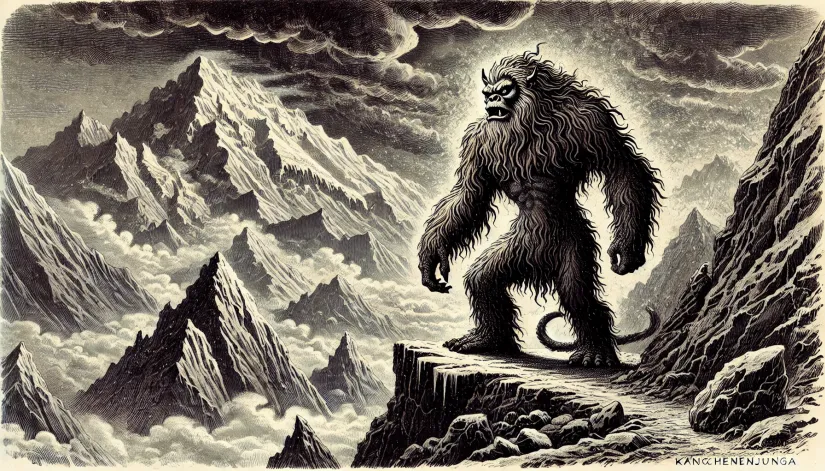
The Kangchenjunga Demon
In the region surrounding Mount Kangchenjunga, the world’s third-highest peak, locals speak of the Kangchenjunga Demon, a Yeti-like creature that guards the mountain’s secrets.
Several Yeti myths are told here. One of these legends speaks about a group of climbers, outsiders, who encountered the Demon.
Local Sherpa believe that Kangchenjunga is not just a mountain. It’s a living entity. Before attempting to scale its heights, climbers must perform rituals and offer prayers to honor the mountain and seek its blessing.
However, one group of foreign mountaineers arrived with the sole aim of conquering Kangchenjunga. They laughed at the local traditions and refused to perform any ceremonies. They dismissed the local advice as mere superstition.
“We didn’t come all this way for fairy tales,” one of the outsiders said.
And so they began their ascent. The weather, initially calm, took a sudden turn. Dark clouds gathered, and an eerie silence fell over the mountain.
Out of nowhere, a massive creature appeared on a distant ridge. It had long arms and a hunched back, unmistakably resembling the Yeti of local Yeti myths. The climbers laughed it off, attributing the sight to altitude sickness.
But as they pushed higher, the mountain seemed to rebel. Snowfields they had crossed minutes before began to shift. Avalanches roared down with terrifying speed, blocking their path and cutting off their retreat.
Panicked, they scrambled for safety. But only a handful made it back to base camp. Still in shock, they told how the mountain itself seemed to be against them.
The locals nodded knowingly. “The Kangchenjunga Demon does not tolerate disrespect,” an elder explained. “You ignored the traditions, and the mountain sent its guardian to warn you.”
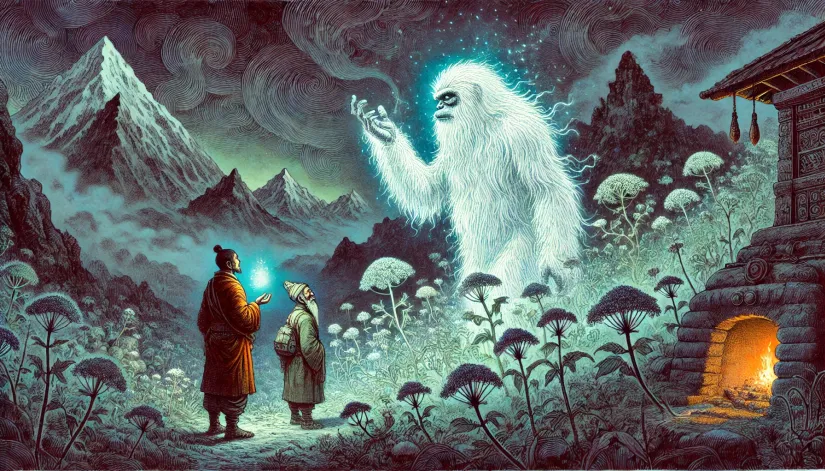
The Healing Yeti Myth
Another interesting Yeti myth is this one from Nepal:
Life flowed peacefully in a quaint Nepalese village tucked between towering peaks and lush forests—until a mysterious illness swept through like a dark cloud.
Villagers, young and old, were struck with high fevers and fatigue. Traditional remedies did zilch, and the local healer was at wit’s end. Hope was fading fast.
One restless night, Pasang (the village elder) had a vivid dream. A majestic Yeti appeared before him, its eyes gleaming like stars, guiding him to a rare herb that grew high in the unforgiving mountains. The Yeti didn’t say a word, but Pasang felt its message loud and clear.
The elder woke up and decided to embark on the treacherous journey.
Related: El Pombero: The Enigmatic Forest Spirit of Guaraní Mythology
Folks in the village thought he was nuts—after all, the path was riddled with sheer cliffs, icy trails, and who knows what else. But the elder was unfazed. He packed some provisions, took his trusting walking stick, and set off at dawn.
The hike was no walk in the park. He braved blistering winds and navigated rocky terrains that would make even a mountain goat think twice.
Yet, whenever he felt like throwing in the towel, a gentle sign—a sudden break in the clouds or a warm gust of wind—spurred him on. It was as if the Yeti was watching his back.
After days of climbing, Pasang reached a secluded alpine meadow just as the Yeti had shown him. And there it was—the strange herb. Its leaves shimmer with an otherworldly glow.
He gathered as much as he could and hightailed it back to the village.
Once back, Pasang concocts a remedy from the mysterious plant. Lo and behold, those who took the medicine bounced back to health in no time flat. The turnaround was so dramatic that even the staunchest doubters had to tip their hats. And the entire village celebrated the end of the plague.
Pasang shared his dream, and the story spread like wildfire. The Yeti wasn’t a monster to be feared but a guardian angel of sorts—a bridge between humans and nature.
Like many other Yeti myths, this one suggests the creature possesses magical powers—like controlling the weather and showing up in dreams to deliver messages.
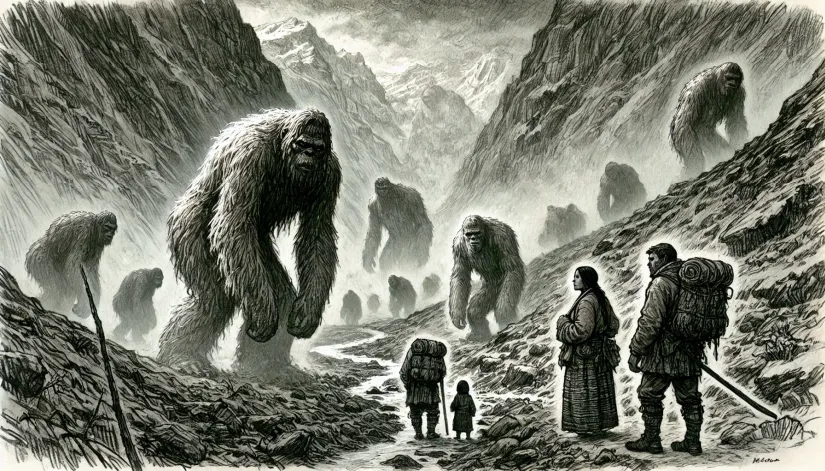
The Disappearance of Sonam
Not all Yeti myths describe the creature as benevolent. Some depict it in a more sinister light. A prime example is the legend of the Yeti abducting beautiful women.
An old Tibetan story recounts the mysterious disappearance of a young woman named Sonam. Known throughout her village for her kindness and striking beauty, Sonam ventured into the forest one day to gather firewood, as she often did.
But her family grew anxious when the sun dipped behind the mountains, and she failed to return home by nightfall.
Villagers organized a search party. They scoured the forest and called out her name. But no sign of Sonam. All they found were large, strange footprints leading deeper into the mountains—footprints too big to be human and unlike any animal tracks they recognized.
Younger villagers had no idea what was happening, but the elders knew. They whispered among themselves, concluding that the Yeti had taken her, captivated by her beauty.
Years later, a group of hunters claimed to have seen a woman matching Sonam’s description living among some mysterious creatures high in the remote valleys. The hunters dared not approach but shared their story upon returning, reigniting the mystery surrounding her fate.
According to this Yeti myth, the creature sometimes abducts women. Either out of loneliness or a desire to start a family of its own. The mountains, they believed, held many secrets, and the Yeti’s fascination with humans was one of them.
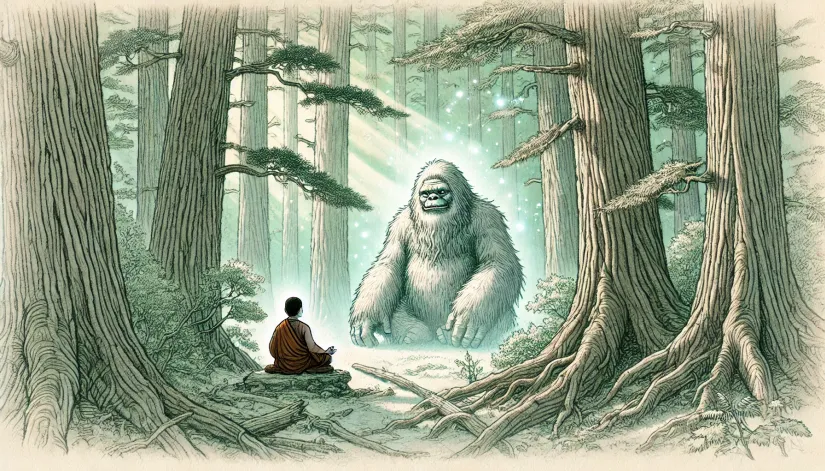
The Wandering Hermit
The legend of the Wandering Hermit Yeti speaks of the Yeti as possessing vast spiritual knowledge and wisdom.
In the remote highlands of Bhutan lived a young monk named Jigme. Looking for enlightenment, Jigme started a journey of solitude in the deep wilderness, seeking a place where he could meditate without distraction.
For months, Jigme meditated in isolation. But, instead of clarity, he found himself wrestling with doubts and questions. The biting cold and relentless solitude weighed too heavy on his spirit.
On a chilly morning, Jigme noticed something unusual—a set of enormous footprints leading away from his modest shelter. Curiosity got the better of him. He wrapped his robe tightly around himself and followed the tracks through dense forests.
The footprints led him to a serene clearing he had never seen before. There, standing amidst ancient cedar trees, he saw a tall creature covered in thick, shaggy fur—the Wandering Hermit Yeti.
But instead of fear, Jigme felt an overwhelming sense of peace wash over him. The Yeti’s eyes glowed softly, reflecting wisdom accumulated over eons.
Without uttering a word, the creature gestured for Jigme to sit beside him.
They settled into meditation, and in that profound silence, Jigme began to receive insights about the universe, the interconnectedness of all living beings, and the true nature of enlightenment.
Visions unfolded before him: rivers flowing into oceans symbolizing life’s cycles, stars illuminating the night sky representing hope in the darkness, and trees rooted firmly in the earth yet reaching for the heavens, illustrating balance and aspiration.
Hours passed like minutes. When Jigme finally opened his eyes, the Yeti was gone, leaving behind a simple wooden carving of a lotus—a symbol of purity and enlightenment. Clutching the token, Jigme felt a renewed purpose and clarity he had never experienced before.
This Yeti myth highlights the creature’s spiritual teacher and guide role. Those who happen upon the Wandering Hermit are said to receive profound insights or visions and powerful blessings or gifts.

The Hunter’s Encounter
In the remote mountain villages of Nepal, tales of the Yeti are as common as the snow that blankets the peaks. One such story comes from a seasoned hunter named Bhim Gurung, whose harrowing experience adds a fascinating chapter to the collection of Yeti myths.
Bhim was famous for his tracking skills and intimate knowledge of the high-altitude forests. However, one autumn morning, he set out alone to hunt deer. This time, he ventured deeper into the mountains than ever before.
He reached a strange clearing where everything was eerily quiet—too quiet. He stopped for a second and listened. No animal sounds. No birds. Not even the wind. Just perfect silence.
Suddenly, he felt the hairs on the back of his neck stand up—a primal warning he couldn’t ignore. He checked his surroundings but saw nothing unusual. Yet, the strange feeling of being watched was overwhelming.
Just as he was about to secure the last snare, a massive figure lunged toward him from the shadows. Standing at least eight feet tall and covered in thick, matted fur, the creature had eyes that glinted with intelligence.
Before he could even react, the beast vanished into the dense trees as swiftly as it had appeared.
Bhim’s heart was pounding. He was the best hunter and yet couldn’t see the huge beast coming. Or maybe he imagined the whole thing? Perhaps that could explain it. So, he decided to call it a day.
Later, when he returned to check his traps, he found them all dismantled—not torn apart, but carefully disassembled with a level of dexterity that no ordinary animal could manage. The snares were laid neatly beside the unset mechanisms, as if to send a clear message.
Who could have done that?
Bhim realized that what he experienced was no ordinary encounter. He actually saw the mythic Yeti. The mountain guardian whose role was to keep nature’s balance undisturbed. Adventuring so far away from his usual hunting grounds, Bhim upset this delicate balance.
After sharing his story with the elders, they confirmed his suspicions: the Yeti, indeed, often intervenes when hunters take more than they need or venture too deeply into sacred areas.
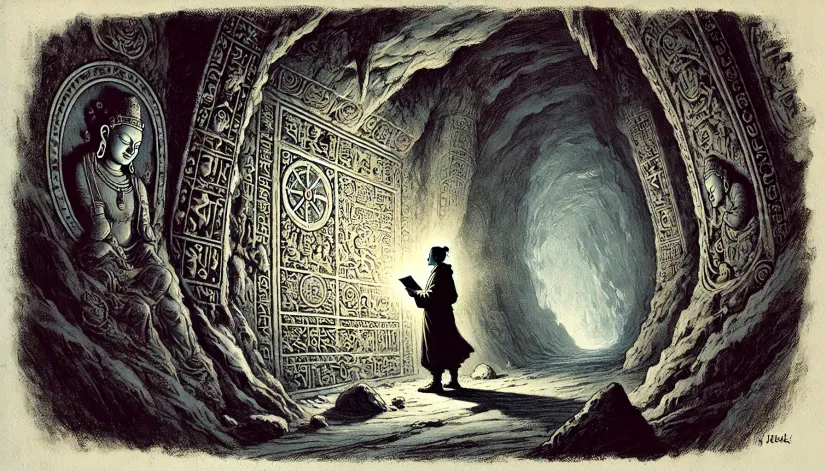
The Yeti’s Cave and its Hidden Treasure
This last Yeti myth is quite an interesting one. How so? Because it’s not just about preserving nature. It’s about great treasures, too.
Legends speak of a young man named Dorje. He lived in a humble village tucked away in the Himalayan foothills. But this village was cursed. The villagers struggled daily. Their crops were failing, and resources dwindling.
Dorje was sick of poverty. He’d had enough of merely getting by one day at a time.
One day, he heard some travelers from another village whispering about a cave high up in the mountains that was said to hold riches beyond imagination. The men were having an old map, trying to figure out the way.
Desperate to change his fate, Dorje decided to follow them. Discreetly.
When they finally made camp for the night, Dorje waited patiently until they were fast asleep. Under the cloak of darkness, he carefully crept into their camp and stole the map.
Now, this wasn’t just any ordinary map. The old parchment was cryptic and filled with ancient symbols. Poor Dorje had no idea how to read it.
But then he noticed some familiar landmarks. Some old ruins where he used to play when he was a child. The spring had now dried out. Things that had shifted over time but for someone familiar with the area still made sense.
Patiently, Droje spent days documenting everything. He took careful notes and figured out the landmarks and where the map was pointing at.
When he was sure he could find the cave, he packed some provisions and left the village.
The mountains were unforgiving. Droje had to face avalanches that thundered like giants awakening, scaled sheer cliffs that seemed to touch the heavens, and crossed icy chasms where one false move meant certain doom. The biting cold numbed his fingers, and the thin air burned his lungs, but Dorje pressed on.
Days turned into weeks. Just when despair was about to overtake him, Dorje noticed peculiar signs—a formation of rocks resembling the symbols on his map and footprints far larger than any human could make. He followed the trail and found a hidden entrance behind some carefully placed branches.
He stepped inside and found the cave illuminated by a soft, otherworldly glow. Expecting piles of gold and gemstones, Dorje was initially crestfallen to find no material treasure.
Instead, the cavern was full of ancient scrolls and carvings etched into the stone walls. Intrigued, Dorje began to read. The scrolls contained profound wisdom—teachings about harmony with nature, the secrets of sustainable farming, healing practices, and philosophies on leadership and community.
Dorje soon realized that the true treasure wasn’t wealth… it was knowledge. He carefully packed as many scrolls as he could and started his journey home.
Once back, he taught the villages about advanced farming techniques that rejuvenated the soil, medicinal remedies that cured longstanding ailments, and principles of unity that strengthened their community bonds.
Soon, the village transformed from a place of scarcity to one of abundance and harmony.
This Yeti myth emphasizes that the greatest riches aren’t material but spiritual and intellectual. It suggests that the Yeti allowed Dorje to find the cave—not to hoard wealth—but to empower his people with knowledge that would elevate their lives for generations to come.

